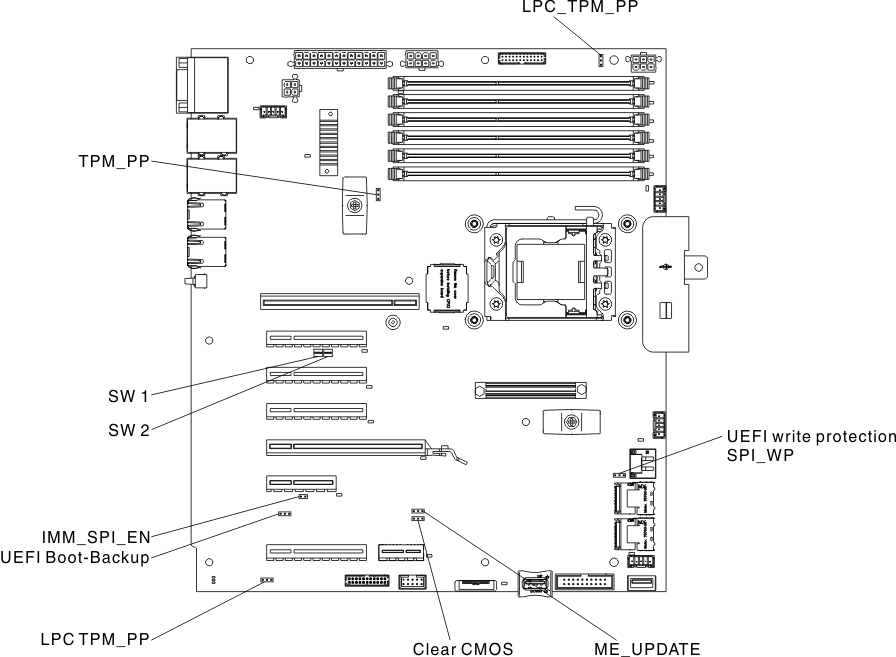System-board switches and jumpers
This section describes the switches and jumpers on the system board.
The following illustration shows the jumper locations.


Note
If there is a clear protective sticker on the top of the switch blocks, you must remove and discard it to access the switches.
The following table describes the jumper on the system board.
| Jumper number | Jumper name | Jumper setting |
|---|---|---|
| ME_UPDATE | PCH ME firmware update |
|
| Clear CMOS | CMOS clear jumper |
|
| SPI-WP | UEFI flash write protection |
|
| UEFI Boot_Backup | UEFI boot - block selection |
|
| LPC_TPM_PP | Host TPM physical presence |
Note TPM physical presence is asserted. (ON) TPM physical presence is not asserted (default off). Note: The physical presence requires manual setting on the server to change the TPM configuration. The TPM is enabled and physical presence is not asserted by default. The physical presence needs to be asserted to activate, deactivate, clear or change ownership of the TPM. |
| TPM_PP | iMM TPM physical presence |
Note The physical presence requires manual setting on the server to change the TPM configuration. The TPM is enabled and physical presence is not asserted by default. The physical presence needs to be asserted to activate, deactivate, clear or change ownership of the TPM. |
| SW1-1 | Host TPM physical presence |
Note The physical presence requires manual setting on the server to change the TPM configuration. The TPM is enabled and physical presence is not asserted by default. The physical presence needs to be asserted to activate, deactivate, clear or change ownership of the TPM. |
| SW1-2 | PASSWORD_OVERRIDE_N | Power-on password override when on (default off) |
| SW1-3 | IMM_FORCE_UPDATE_N | Default off |
| SW1-4 | FORCE_IMM_RESET_N | Default off |
| SW2-1 | FORCE_RTMM_RESET_N | Default off |
| SW2-2 | RTMM FLASH | Default off |
| SW2-3 | POWER_PERMISSION_N | Force power permission (default off when F/W is ready) |
| IMM_SPI_EN | IMM_SPI_HALF_ROM_EN_N | To allow override of the boot half (Default: jumper open) |
Note
| ||
Important:
- Before you change any switch settings or move any jumpers, turn off the server; then, disconnect all power cords and external cables. Review the information in Safety and Installation guidelines, Handling static-sensitive devices, and Turning off the server.
- Any system-board switch or jumper blocks that are not shown in the illustrations in this document are reserved.
Give documentation feedback